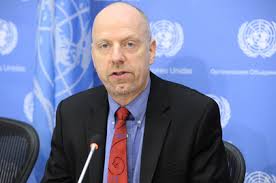A new UN report issued in New York on Friday said that the world population was increasingly becoming urban, with more than half of the population currently living in urban areas.
The 2014 revision of the World Urbanisation Prospects produced by the UN Population Division of the Department of Economic and Social Affairs (DESA) said the world’s urban population was expected to surpass six billion by 2045.
It said much of the expected urban growth would take place in countries of the developing regions, particularly Africa and the largest urban growth would take place in India, China and Nigeria.
It added that the three developing countries would account for 37 per cent of the projected growth of the world’s urban population between 2014 and 2050.
According to the report, India is projected to add 404 million urban dwellers, China will add 292 million and Nigeria will add 212 million urban dwellers by 2050.
The report noted that the urban population of the world grew rapidly from 746 million in 1959 to 3.9 billion in 2014.
It said Asia, in spite of its lower level of urbanisation, was home to 53 per cent of the world’s urban population.
John Wilmoth
John Wilmoth, the Director of the Population Division of DESA, said that as a result, the countries would face numerous challenges in meeting the needs of their growing urban populations.
He said such demands as housing, infrastructure, transportation, energy and employment, as well as basic services such as education and health care would be grossly inadequate.
Wilmoth said “managing urban areas has become some of the most important development challenges of the 21st century.’’
He noted that 54 per cent of the world’s population live in urban areas, a proportion that was expected to increase to 66 per cent by 2050.
He said the UN projection showed that urbanisation combined with the overall growth of the world’s population could add another 2.5 billion people to urban populations by 2050, with close to 90 per cent of the increase in Asia and Africa.
He added that in 1990, there were 10 “mega-cities” with 10 million inhabitants, which were home to 153 million people and slightly less than seven per cent of the global urban population at that time.
He pointed out that in 2013, there were 28 mega-cities worldwide, home to 453 million people.
The director said that as of today, there were 16 mega-cities located in Asia, four in Latin America, three each in Africa and Europe, and two in Northern America.
He noted that that by 2030, the world projected to have 41 mega-cities with 10 million inhabitants or more.
“Tokyo remains the world’s largest city with 38 million inhabitants, followed by Delhi with 25 million, Shanghai with 23 million, while Mexico City, Mumbai and Sao Paulo have around 21 million inhabitants each, as Osaka has just over 20 million,’’ he said.
“The New York-Newark area and Cairo complete the top 10 most populous urban areas with around 18.5 million inhabitants each,’’ he added.
He said many of the fastest growing cities in the world were relatively small urban settlements.
Wilmoth said the rural population of the world had grown slowly since 1950 and was expected to reach its peak around 2020, while the global rural population was now close to 3.4 billion and was expected to decline to 3.1 billion by 2050.
He said Africa and Asia were urbanising rapidly, yet they reamined home to nearly 90 per cent of the world’s population, as India had the largest rural population with 857 million, followed by China with 635 million.
Wilmoth said that to achieve sustainable urbanisation, a successful urban planning agenda would require that attention be given to urban settlements of all sizes.
He said cities offer important opportunities for economic development and for expanding access to basic services, including health care and education, for large numbers of people through proper management.
Observers said the 2014 revision of the World Urbanisation Prospects provided new and updated information on global urbanisation trends and city growth.
They said such information was vital for setting policy priorities to promote inclusive, equitable and sustainable development for urban and rural areas alike.
They said the latest revision had expanded the number of cities and provided for the first time, population estimates and projections for all of the world’s urban settlements with 300,000 inhabitants or more in 2014. (Xinhua)













